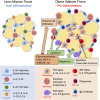Adipose tissue inflammation and metabolic dysfunction in obesity
- PMID: 33356944
- PMCID: PMC8294624
- DOI: 10.1152/ajpcell.00379.2020
Adipose tissue inflammation and metabolic dysfunction in obesity
Abstract
Several lines of preclinical and clinical research have confirmed that chronic low-grade inflammation of adipose tissue is mechanistically linked to metabolic disease and organ tissue complications in the overweight and obese organism. Despite this widely confirmed paradigm, numerous open questions and knowledge gaps remain to be investigated. This is mainly due to the intricately intertwined cross-talk of various pro- and anti-inflammatory signaling cascades involved in the immune response of expanding adipose depots, particularly the visceral adipose tissue. Adipose tissue inflammation is initiated and sustained over time by dysfunctional adipocytes that secrete inflammatory adipokines and by infiltration of bone marrow-derived immune cells that signal via production of cytokines and chemokines. Despite its low-grade nature, adipose tissue inflammation negatively impacts remote organ function, a phenomenon that is considered causative of the complications of obesity. The aim of this review is to broadly present an overview of adipose tissue inflammation by highlighting the most recent reports in the scientific literature and summarizing our overall understanding of the field. We also discuss key endogenous anti-inflammatory mediators and analyze their mechanistic role(s) in the pathogenesis and treatment of adipose tissue inflammation. In doing so, we hope to stimulate studies to uncover novel physiological, cellular, and molecular targets for the treatment of obesity.
Keywords: adipocytes; immunity; inflammation; insulin resistance; obesity.
Figures


References
-
- Emerging Risk Factors Collaboration. Wormser D, Kaptoge S, Di Angelantonio E, Wood AM, Pennells L, Thompson A, Sarwar N, Kizer JR, Lawlor DA, Nordestgaard BG, Ridker P, Salomaa V, Stevens J, Woodward M, Sattar N, Collins R, Thompson SG, Whitlock G, Danesh J. Separate and combined associations of body-mass index and abdominal adiposity with cardiovascular disease: collaborative analysis of 58 prospective studies. Lancet 377: 1085–1095, 2011. doi:10.1016/S0140-6736(11)60105-0. - DOI - PMC - PubMed
-
- Singh GM, Danaei G, Farzadfar F, Stevens GA, Woodward M, Wormser D, Kaptoge S, Whitlock G, Qiao Q, Lewington S, Di Angelantonio E, Vander Hoorn S, Lawes CM, Ali MK, Mozaffarian D, Ezzati M; Global Burden of Metabolic Risk Factors of Chronic Diseases Collaborating G, Asia-Pacific Cohort Studies C, Diabetes Epidemiology: Collaborative analysis of Diagnostic criteria in E, Emerging Risk Factor C, and Prospective Studies C. The age-specific quantitative effects of metabolic risk factors on cardiovascular diseases and diabetes: a pooled analysis. PLoS One 8: e65174, 2013. doi:10.1371/journal.pone.0065174. - DOI - PMC - PubMed
Publication types
MeSH terms
Substances
Grants and funding
- DK096521/HHS | NIH | National Institute of Diabetes and Digestive and Kidney Diseases (NIDDK)
- R01 DK096521/DK/NIDDK NIH HHS/United States
- HL117724/HHS | NIH | National Heart, Lung, and Blood Institute (NHLBI)
- R01 HL117724/HL/NHLBI NIH HHS/United States
- HL141108/HHS | NIH | National Heart, Lung, and Blood Institute (NHLBI)
LinkOut - more resources
Full Text Sources
Other Literature Sources
Medical

